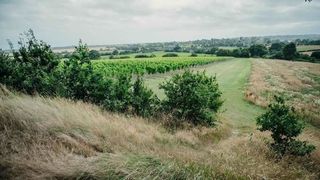“When we first started preparing the vineyard sites for planting,” recalls Matthew Hope, Assistant Manager at The Nest, “we had to do a lot of soil analysis and turning-over of soil.” That’s when the first of many fascinating archaeological objects appeared.
Gusbourne’s Chief Vineyard Manager Jon Pollard wasn’t surprised. “We always knew there was plenty of history beneath our feet, but we’d been busy setting up the vineyards and the winery and didn’t give it much thought. Although we were aware of a hoard of around 500 Anglo-Saxon coins found on the estate before our founder Andrew Weeber acquired the property.” Those coins, believed to be buried near Appledore around AD 1051-52, were discovered by local metal detectorists in 1997 and came from 34 different mints all over England.
But the soil had much more treasure to be unearthed. “There are 150 acres under vine here, so there’s quite a lot of land to cover over different altitudes. We asked a couple of local archaeological groups to scour the land. They found a significant number of objects,” says Matthew.
From a Neolithic-era flint knife to World War Two ammunition rounds, the finds form a timeline of daily life and dramatic events over history. Silver coins, military badges, buttons and buckles, bullet rounds, jewellery and domestic objects are among some of the well-preserved objects found buried in the soil that plays a critical role in our winemaking.
“We always knew there was plenty of history beneath our feet”
“The Gusbourne Estate itself, and the area around Appledore, is steeped in maritime history,” says Matthew. “Going back to the Roman occupation, Appledore was actually sitting on the shoreline looking out over the English Channel. Even though we’re now around eight miles inland, at one point the shoreline would have come right up to the bottom of our vineyards. Over time, the coastline has shifted and changed dramatically. Elements of longshore drift caused the formation of sea lagoons and marshes, which put Appledore on the estuary of the River Rother.”
The Vikings landed at Appledore in AD 892, when the village was a port – one of the limbs of the old Cinque Ports, the confederation of five port settlements dotted around the coast of Kent and Sussex, between Sandwich and Hastings. Some of the objects found at Gusbourne are evidence of Appledore being a port – coins, trading weights, militaria.
“This maritime history plays a big role in why the vines grow so well here too. Proximity to the coast helps temper the climate and gives us a warming effect in winter and autumn,” Matthew explains. “We get this lovely maritime breeze rolling in off Romney Marsh from the sea, which helps with ventilation and airflow among the vines.”
The area’s more recent history is equally captivating. “Local detectorists uncovered numerous ammunitions rounds left over from the Second World War,” says Jon. The area around Romney Marsh was active during the war, dotted with airfields and anti-aircraft positions. Witness the .50-calibre Browning machine gun bullets found at Gusbourne that came from Spitfires engaged in aerial battles over this part of the country.
Some of the more fascinating archaeological finds include a c.16th-century bronze livery ring with a lion-and-shield insignia and silver coins from the reign of King John (1166-1216). One coin had a quarter of it missing – it was common back then for coins to be snipped in order to pay a debt.
The detectorists are continually making new discoveries at Gusbourne Estate and in autumn 2020 unearthed their oldest find to date here. A Roman Steelyard weight found at the bottom of Mill Hill has been identified to date from AD43-AD200. The metal running through it is believed to be a copper alloy that may have formed a loop to help in its use as a weight. The steelyard weight is roughly equal to 1 Roman Unica (modern ounce).
Visit Gusbourne Estate to discover more about our history and to view some of the fascinating objects found in our vineyards.
You may also like...
Behind the label: What's in a name?









